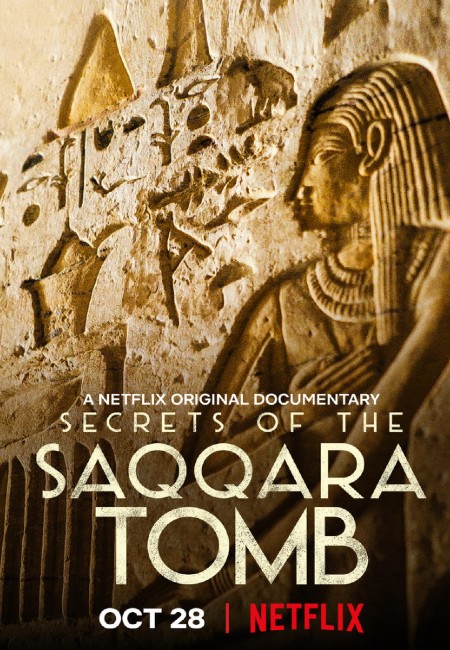A well-made documentary about a compelling subject is always going to be a riveting thing to watch; even more so, when it takes the time to fully investigate the topic at hand and give it time to breathe and tell its story as fully and completely as it deserves.
Secrets of the Saqqara Tomb is given a luxurious two-hour run time to explore a series of discoveries made in the Bubasteion Necropolis, part of the sprawlingly ancient Saqqara Necropolis wherein lies the Step Pyramid aka The Pyramid of Djoser and as the documentary beautifully illuminates, a host of burial sites of great antiquity wait to be resumed from beneath the sands.
The burial chamber that is the subject of this fascinating documentary belonged to Wahtye, a high-ranking priest from the Fifth Dynasty of ancient Egypt, who it appears was rather consumed with his own greatness and not afraid to announce it to the world.
Well, to be fair to those who might enter his tomb, a frighteningly small number you would hope, by way of a slew of hieroglyphics that adorn the chamber, all of them in vividly colourful condition, amazing in and of itself given that the tomb is estimated to be about 4400 years old.
You can likely thank the preserving power of dry desert for this gem whose secrets are unearthed by an Egyptian team of archaeologists who take an enormous amount of pride in taking back the documenting of the country’s heritage from foreign teams.
They are not militant about it but there is a quiet pride in the way in which the people leading and working on the dig go about giving life back to the story of Wahtye who has lain undisturbed for millennia and in a tomb that appears not to have been disturbed at all.
While the discoveries in the shafts of the chamber are impressive (including the only known mummified lion cub), leading to a detective story of epically ancient proportions about what happened to the priest and his family, it’s what happens in and around the discovery that is almost as fascinating.
There is a reverence of sorts to the way in which the mostly men on the team approach their task, given voice quite movingly at times by Hamada, the youngest member of the team who describes the place they are digging in as “quite magical” and a mystical place in which to work.
Keeping it real, he is also honest enough to admit that working down in cramped, hot shafts bringing up skeletons and coffins, many of them adorned with exquisite artwork, is less than glamorous and not something he particularly loves in and of itself.
He is, however, quick to point out, that when you discover the remains of people who died and were buried over 4000 years earlier, who are only now being seen by the living world again, it is intensely moving and something very special of which to be a part.
What makes Secrets of the Saqqara Tomb is that eschews the modern trend in documentaries of breathlessly announcing each and every discovery in a staccato visual style with am almost tabloid hyping of events.
There are times with other documentaries where you just wish they’d be done with the fevered theatrics and just let the discoveries and their attendant story just speak for itself.
Thankfully that is precisely what Secrets of the Saqqara Tomb does throughout, its longer than usual running time giving it the luxury of letting events play out sometimes in real time, so we witness the discovery of a colourful wooden coffin, the careful way that its layers of sand and grit are brushed away and the excitement with which the team, led by Egyptologist Mohammad Mohammad Yousef, greet everything that emerges both from the tomb and the ground around it which reveals treasures in abundance too.
In fact, while the tomb’s unearthing is endlessly compelling, and Secrets of the Saqqara Tomb gives it due time to tell its story, it’s what is found in the sands around it that it exciting too.
It’s these discoveries that almost steal what is already an impressive show.
From beneath the sands emerge small statues of the warrior goddess of healing Sekhmet, a piece of a marble statue that may belong to one found a season or two earlier, and all manner of small statuettes and coffins which makes you wonder what else lies beneath the shifting sands of the necropolis.
If you are even remotely interested in archaeology as a whole, and Egyptology in particular you will find Secrets of the Saqqara Tomb a brilliant way to spend two hours because it allows you time to fully appreciate what has been unearthed.
It’s a lesson to the more manic documentaries out there that try to create a sense of epic, urgent scale by treating the emergence of every discovery as if its a rock star item in the making; what Secrets of the Saqqara Tomb teaches us is that ancient tombs, coffins and statues, and the window they give us on an already-amazing civilisation, are plenty exciting all on their own and don’t get hyped-up razzle-dazzle to make an impact.
In fact, when you allow the artefacts to simply be and to allow their discoverers to tell their story, quietly and with informed reverence and excitement for the task at hand, you end up with a story so immersively captivating that it doesn’t need shiny, fast-paced bells and whistles, happily able to impress on its own unadorned merits and regale with tales of a place and time and person so long removed from the here-and-now and yet no less fascinating for that.
Secrets of the Saqqara Tomb is currently streaming on Netflix.
